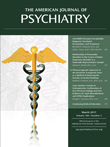T
o the E
ditor: In the October 2010 issue of the
Journal, Melanie S. Harned, Ph.D., et al. (
1) reported on an important study examining the relationship between posttraumatic stress disorder (PTSD) and borderline personality disorder. This is an important area of inquiry, and the authors have done an admirable job in comprehensively assessing their sample. However, the study has several limitations, and the conclusions are not consistent with recent studies that were not cited.
As stated by Harned et al. (
1) themselves, we want to underscore the fact that the small size and select nature of their study (94 women) make it difficult to draw conclusions. They conducted numerous comparisons across variables without any adjustment for multiple comparisons. Furthermore, they have not cited recent large epidemiologic studies examining the association between PTSD, borderline personality disorder, and suicide attempts (
2–4).
Harned and colleagues' conclusion that frequency, intent, and lethality of suicide attempts are the same for individuals with borderline personality disorder with and without PTSD is inconsistent with recent work. Cougle et al. (
2), using the U.S. National Comorbidity Survey Replication data (N=5,692), demonstrated that PTSD is associated with suicide attempts, even after adjusting for the effects of borderline personality disorder. We extended these findings using the National Epidemiologic Survey on Alcohol and Related Conditions (N=34,653), by showing that PTSD is associated with suicide attempts after adjustment for all sociodemographic factors and axis II disorders (
3). Pagura et al. (
4) were the first to examine comorbidity of PTSD and borderline personality disorder in a large nationally representative sample by comparing individuals with PTSD alone (N=1,820), borderline personality disorder alone (N=1290), and comorbid PTSD and borderline personality disorder (N=643). This study found that individuals with comorbid PTSD and borderline personality disorder had greater odds of lifetime suicide attempt compared to individuals with either condition alone (
4).
We have shown that individuals with co-occurring PTSD and borderline personality disorder have higher odds of having a suicide attempt than either disorder alone (
3,
4). These findings are in contrast to the findings of Harned and colleagues' study (
1). We believe the discrepancy between the epidemiologic studies and the Harned et al. study is due to the differences in sample size. We note that epidemiologic studies cited above are limited by lack of assessment of lethality of suicide attempts, a strength of Harned and colleagues' study. We suggest that future clinical studies need to gather a larger sample and include a comparison group of women with PTSD.

